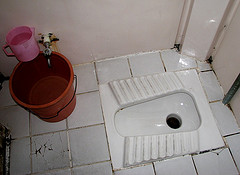6 Foreign Travel Bathroom Safety Tips You Don’t Want to Miss
10 August 2012
Every traveler has a few good bathroom stories, but let’s face it: there are significant variations in toilet customs, where they’re found, how they operate, what features they come with and more.
Foreign toilet rules can be perplexing at the least and traumatic at their worst. For example, in some countries, the plumbing is so frail that toilet paper will effectively jam it up. You’ll know if you see the waste baskets filled with soiled paper. (Hint: If you see that, be sure to leave yours there too or risk flooding the block!)
Unfortunately, the side effect of strange toilets can sometimes be not washing your hands as thoroughly as you should and that leaves a traveler at risk of developing or spreading a slew of illnesses (some very serious) including, but not limited to:
- E. coli
- Giardiasis
- Salmonella
- Hand Foot Mouth
- Hepatitis A
- Shigellosis
The transfer of fecal-to-oral diseases occurs when an infected person doesn’t use good hand-washing techniques with soap and water.
Tracking down a foreign toilet when you need it and staying safe after using it comes down to one key step: planning ahead.
1. Learn to say ‘where’s the toilet’ in the foreign language
While not exactly a safety tip, learning to say it will save you loads of time when the urge strikes. Most travel guidebooks will give you this common phrase, but you can also find smartphone apps that can help with lavatory lingo.
Be sure you’re pronouncing it correctly too – or who knows where you’ll be directed?
2. Have spare change – for pay toilets and tipping
Here’s a bit of history: before the 1970s, it was commonplace to pay to use the bathroom in the U.S. until a grassroots organization called the Committee to End Pay Toilets in America (CEPTIA) convinced local governments across the nation to ban them.
Still, paying to use the public restroom remains a custom in Europe and in many other countries, and, of course, when you’re in no state to argue you’ll pay it. Keep a stash of coins on hand just for this purpose. In some toilets, the toilet is free but you’ll find a tip dish by the entry and an attendant on watch. It can be hard to know how much to tip, but most travel experts indicate that the equivalent of 25-50 cents is fine.
3. You may have to engineer privacy
In large parts of rural Africa, toilets are screened by a fence and not a solid door. In parts of China you may encounter toilets with no doors at all, and this is where you get to make a decision: leave your dignity at the doorway or engineer your own privacy.
If you’re carrying a collapsible travel umbrella, you can open it and use it to shield your business from others. If you’re traveling with others, you can take turns blocking the view by standing watch in the doorway with your back to your companion.
4. Master the art of clean squatting
In some areas, you’ll find a style of toilet that’s foreign to most of Americans – a squat toilet. Squat toilets are common in Asia, the Middle East, Africa, South America and even parts of Europe.
We won’t go into the particulars here, but see this resource for the details: How to use a squat toilet from Flying Coach
5. BYOTP
While Americans expect plenty of toilet paper on hand, you guessed it: toilet paper is not always available in foreign toilets. In some toilets, there’s a charge for it. See the lovely lady in the corner who’s willing to sell you some sheets.
In other places, you will find alternative methods of cleaning up ranging from high-tech washing and drying mechanisms to a simple bucket of water with a ladle.
As you may have expected, it’s best to plan ahead so you know the risks and bring your own toilet paper. To avoid having to jam an entire roll of the stuff in your bag, the easier option is to carry it folded flat in a plastic zippered bag instead.
6. Carry antiseptic wipes and hand sanitizer
Many foreign toilets don’t have the hot water, soap dispensers and multiple hand-drying options we’re used to in the U.S. So, to keep yourself safe from illness, bring your own antiseptic wipes and use them carefully to wash your hands after using the toilet. If the toilet you’re using is especially suspect, you might want to clean the seat prior.
Once you arrive at your hotel after stepping out or at a restaurant for a meal, visit the washroom and thoroughly scrub your hands with water and soap before doing anything else.
When nature calls …
When nature calls, it’s also useful to remember these tips:
- Any place that serves food or drinks has a toilet, and if you ask politely, they’ll often let you use it even if you’re not a patron.
- Bars are useful because you can pretend you’re looking for someone and go right in.
- If you’re visiting a historic site or museum, use the toilet when you enter and when you leave to maximize the free options.
- American chains like fast-food joints usually have a public restroom and you can avoid asking to use it (unless it’s locked). Buy a small coffee or soda if they give you grief.
- Fancy hotels in some countries are as lovely as any castle and the lobbies usually have restrooms – with soft toilet paper too!
Damian Tysdal is the founder of CoverTrip, and is a licensed agent for travel insurance (MA 1883287). He believes travel insurance should be easier to understand, and started the first travel insurance blog in 2006.

